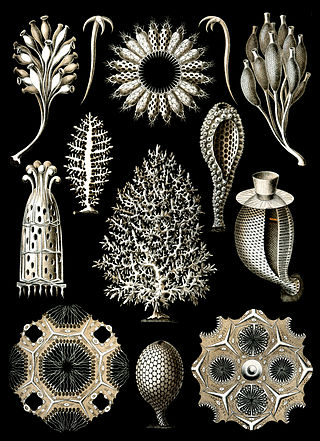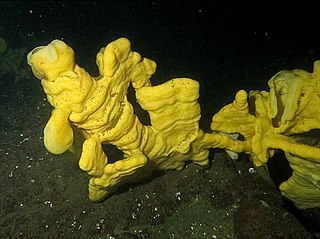
The calcareoussponges are members of the animal phylum Porifera, the cellular sponges. They are characterized by spicules made of calcium carbonate, in the form of high-magnesium calcite or aragonite. While the spicules in most species are triradiate, some species may possess two- or four-pointed spicules. Unlike other sponges, calcareans lack microscleres, tiny spicules which reinforce the flesh. In addition, their spicules develop from the outside-in, mineralizing within a hollow organic sheath.

Pareuthria is a genus of sea snails, marine gastropod mollusks in the family Cominellidae.
The Mount Stephen trilobite beds are a series of fossil strata on Mount Stephen, British Columbia that contain exceptionally preserved fossil material. Part of the same stratigraphic unit as the Burgess Shale deposit, many non-mineralized parts are preserved; in addition, a high density of trilobite fossils is present.

Arthur Dendy was an English zoologist known for his work on marine sponges and the terrestrial invertebrates of Victoria, Australia, notably including the "living fossil" Peripatus. He was in turn professor of zoology in New Zealand, in South Africa and finally at King's College London. He was a Fellow of the Royal Society.

Ceratitidae is an extinct family of ammonite cephalopods.

Turonia is an extinct genus of sea sponges belonging to the class Demospongiae.

Siphoniidae is an extinct family of sea sponges belonging to the class Demospongiae.

Tetractinellida is an order of sea sponges belonging to the class Demospongiae. First described in 1876, this order received a new description in 2012 and replaced the two orders Astrophorida and Spirophorida, which then became sub-orders as Astrophorina and Spirophorina.
Vetulina is a genus of sea sponges in the subclass Heteroscleromorpha. It is the only genus in the monotypic family Vetulinidae and the monotypic order Sphaerocladina.
Protomonaxonida is an extinct order of sea sponges. It is a paraphyletic group gathering the most ancient species from the Burgess Shale to modern sponges.
Costifer is a family of sea sponges. It is the only genus in the monotypic family Isoraphiniidae.

Amphidiscosida is an order of hexactinellids. The Amphidiscosida are commonly regarded as the only living sponges in the subclass Amphidiscophora.

Eocyathispongia is a genus of sponge-like organisms which lived in the Ediacaran period about 60 million years before the Cambrian. The current fossil record has found this genus in only one location, the Doushantuo Formation in Guizhou, China. It lived in the shallow parts of seas, filter feeding.

Coeloptychium is an extinct genus of lychniscosidan hexasterophoran sea sponge which has often been used as an index fossil. Its remains have been found in Cretaceous sediments in Germany, Belgium, France and the UK. Coeloptyhcium is best preserved in Campanian sediments in Germany. The type species, C. agaricoides, was named in 1826.
Myrmecioptychium is an extinct lychniscosidan hexasterophoran sea sponge, which is a subgenus of Coeloptychium. Its remains have been found in Santonian-Maastrichtian-aged deposits in Broitzem, Germany and Poland. The type species, M. bodei, was named in 1912.
Sceptrulophora is an order of hexactinellid sponges. They are characterized by sceptrules, a type of microsclere with a single straight rod terminating at a bundle of spines or knobs. An anchor- or nail-shaped sceptrule is called a clavule. A fork-shaped sceptrule, ending at a few large tines, is called a scopule. A broom-shaped sceptrule, ending at many small bristles, is called a sarule.

Euretidae is a family of glass sponges in the order Sceptrulophora.
Chonelasmatinae is a subfamily of sea sponge in the family Euretidae.

Aphrocallistes is a genus of sponges belonging to the family Aphrocallistidae.
Craticulariidae is a family of sponges belonging to the order Sceptrulophora.











